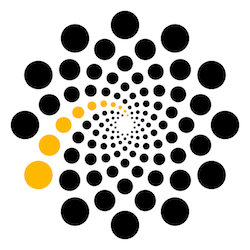 What can you see? At the Illusion of the Year 2012 competition, Shapiro & Kistler showed a variation of the wagon wheel effect, the colour wagon wheel. Instead of spokes, they put dots at even intervals of 30 degrees on a disc. Like the wagon wheel effect, the black dots rotate anti-clockwise. But if some dots are coloured, these rotate clockwise with the disc. So it looks as if two movements are superimposed on each other.
What can you see? At the Illusion of the Year 2012 competition, Shapiro & Kistler showed a variation of the wagon wheel effect, the colour wagon wheel. Instead of spokes, they put dots at even intervals of 30 degrees on a disc. Like the wagon wheel effect, the black dots rotate anti-clockwise. But if some dots are coloured, these rotate clockwise with the disc. So it looks as if two movements are superimposed on each other.
What can you do? After the program color wagon wheel has started, the black dots appear to rotate counterclockwise, which is the standard wagon wheel effect. There are four variations of the colour wagon wheel that can be selected by pressing the corresponding button:
(s) Standard wagon wheel effect.
(1) One dot is coloured per ring.
(c) Colouring of the dots, whereby the colour is slightly changed from ring to ring.
(m) On each ring the colour varies from dot to dot.
(a) On each ring the dots are coloured alternatively in the same way.
By default, only the rotation can be changed (0 ≤ aps_1 ≤ 380). By pressing the p-key, the properties of the dots as well as of the disc are shown (color, brightness, saturation). They can be hidden again by pressing the h-key). Pressing key 1 you can study at what values of aps the colored dots rotate in the opposite direction to the black dots. Does this also apply to coloured dots (key c)? What about multicoloured dots (key m)? Try for example delta_color = 6! You should see movements in opposite directions; but what happens when dot_brightness is then decreased?
What else can you do? For better clarity, other values are hidden. If you select the Variables palette in the Snap!-programming environment, you can unhide and reactivate them as sliders. By default 10 rings with a gap of 5 pixels are displayed. With n_rings you can change their number (1 ≤ n_rings ≤ 10), with delta_rings their distance (1 ≤ delta_rings ≤ 10, depending on n_rings). What is the minimum number of n_rings (in combination with delta_rings) needed to see the effect?
Related topics: Wagon Wheel Effect
References:
Shapiro
, A. &
Kistler, W.
. (2016). Color Wagon Wheel. Illusion of the Year 2012 Finalist. Available as download.





